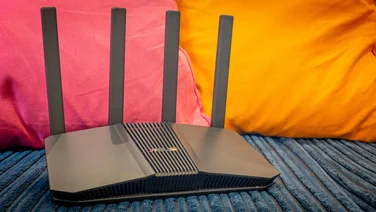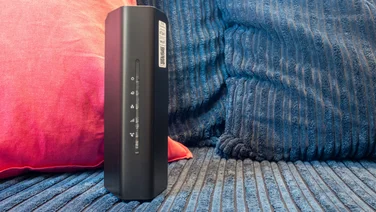To help us provide you with free impartial advice, we may earn a commission if you buy through links on our site. Learn more













- Good download speeds
- Plenty of network sockets
- Slick management interface
- No Wi-Fi 6E or multi-gigabit Ethernet
- Appalling value for money
There may be a cost-of-living crisis on, but Netgear doesn’t seem too worried about keeping prices down. Last month it debuted the Orbi RBK763, a mesh kit with a steep £600 price tag. Now it has unveiled the Orbi RBK863, costing a massive £1,099.
Believe it or not, this isn’t the most expensive consumer Orbi system you can buy. That’s the Wi-Fi 6E-enabled Netgear Orbi RBKE963, which goes for an immense £1,499. But the RBK863 sits at the top of the regular Wi-Fi 6 range; it replaces the old Orbi RBK853, formerly Netgear’s premium mesh in the days before Wi-Fi 6E came along.
In fact, the RBK863 uses exactly the same radio configuration as its predecessor. Sadly, that’s not a plus point. Modern rivals use newer Wi-Fi hardware that can deliver competitive performance at lower prices.
Netgear Orbi RBK863 review: What you need to know
The RBK863 is a tri-band mesh that uses a dedicated 5GHz backhaul band in addition to the usual 2.4GHz and 5GHz client radios. The 2.4GHz radio is rated at an unusually speedy 1.2Gbits/sec, while the two 5GHz radios claim top speeds of 2.4Gbits/sec each, achieved with the help of 4×4 MU-MIMO.













Wired networking is well covered, too, with four LAN ports on each of the three units, plus a 10GbE WAN port. And, unlike the original RBK853, the system comes with a year-long subscription to the Netgear Armor online service: the retail package is called the RBK863S, for “security”.
READ NEXT: The best Wi-Fi extenders to buy
Netgear Orbi RBK863 review: Price and competition
As we’ve noted, the Orbi RBK863 costs £1,099 for three stations. At present there isn’t a two-station option. That means that very nearly any router or mesh system you could possibly buy will be significantly cheaper. Leaving aside heavyweight business-oriented gear, the only mesh we’ve tested that’s more expensive is the flagship Orbi RBKE963, which raises the performance stakes with Wi-Fi 6E.
Not that there’s any need to pay through the nose for 6E. We’re big fans of the 6GHz-enabled TP-Link Deco XE75 mesh, which costs a far more reasonable £350 for a twin-pack. The Google Nest Wifi Pro is a three-station 6E system for £380, although performance is so-so.
If you can live without the latest wireless technology, there are plenty of good Wi-Fi 6 options, too. Netgear’s own Orbi RBK763 is a strong alternative to the RBK863, with a slightly more reasonable £600 price tag. The Linksys Atlas Pro 6 is another option that gives perfectly good performance at £407. If price is a priority, a budget mesh such as the D-Link M15 Eagle Pro AI Mesh can cost as little as £120.
We could go on all day. There are dozens of other meshes out there, with designs and capabilities to suit almost every need, all priced much more cheaply than the RBK863.
Netgear Orbi RBK863 review: Design and features
Well, it’s definitely an Orbi – the family resemblance is unmistakeable. In fact, the RBK863 units are all but identical to the old RBK853 ones, with the same 254mm-tall casing and a footprint that extends to a maximum of 191 x 71mm.













There are just two differences to be seen. The plastic trim around the outer edges now has a subtle champagne colouring, where the old model was silver-grey. I prefer the new look; it adds a bit of warmth.
The other change is hidden at the back, where the WAN connector has been boosted from 2.5GbE to 10GbE. While this is undeniably an upgrade, it’s a completely pointless one: even if your internet line is faster than 2.5Gbits/sec, you’ll see very little benefit from a 10GbE connection, because all the LAN ports remain at gigabit speeds. Multi-gigabit link aggregation won’t help either because it’s only supported for the WAN connection, not for client devices.
Still, there are a good number of sockets: four Ethernet ports on the main unit are joined by a further four apiece on each satellite. There’s no USB but that’s the norm for Orbi systems, and meshes in general.













The setup process is the same as with all Orbi systems: the mobile app invites you to scan the sticker on the main unit to identify it, then walks you through setting your network name and security options. Once the network is running, you can use the same app to check up on your connected clients, adjust some basic wireless settings and use Netgear’s excellent Wi-Fi Analytics tool to measure signal strength and interference in different locations around your home.













The app also includes Netgear’s optional Armor and Parental Control services. The former covers network security scanning and entitles you to install standalone Bitdefender security software on all compatible devices on your network: after the first year, it’s £85 a year to continue the subscription. The parental control service offers detailed internet access management and monitoring, across phones and tablets as well as computers, and costs another £50 a year.
For more advanced configuration, the web-based management portal lets you set up things such as IP address reservation and port forwarding. You can’t split the 2.4GHz and 5GHz bands into individual networks but you can activate a separate guest network, and a third isolated “IoT” network for smart devices. Netgear’s OpenVPN server is included too, so you can dial into your home network over any internet connection, though you can’t configure the Orbi to route outbound traffic through a third-party VPN service.













READ NEXT: The best wireless router to buy
Netgear Orbi RBK863 review: Performance
Although the Netgear RBK863 uses the same radio hardware as its predecessor, Netgear claims its upgraded antenna design boosts coverage and performance by 20%. In fact, the purported range of the system has gone up from 550m² to 740m², which is closer to 35%.
To test performance I set up the main router unit in my study at home, and connected it to an Asustor Drivestor 4 Pro NAS appliance. I placed the second unit at the opposite end of the adjoining bedroom, with the third in the downstairs living room.
I then connected to the Orbi network from my usual test laptop and tried copying a series of 100MB files to and from the NAS in different locations around my home. Here are the speeds I saw, along with results from a selection of other meshes:
| MB/sec | Bathroom download | Bedroom download | Kitchen download | Living room download | Study download |
| Netgear Orbi RBK863 | 51.7 | 73.5 | 41.1 | 72.3 | 83.9 |
| Google Nest Wifi Pro (6GHz) | 21.7 | 32.8 | 18.5 | 53.9 | 61.2 |
| Linksys Atlas Pro 6 | 44.3 | 54.8 | 46.2 | 50.4 | 60.2 |
| Netgear Orbi RBK763 | 45.4 | 77.6 | 47.2 | 63.4 | 97.1 |
| TP-Link Deco XE75 (6GHz) | 76.5 | 81.7 | 64.8 | 81 | 84.1 |
| Netgear Orbi RBKE963 (6GHz) | 72.7 | 100.3 | 79.4 | 77.1 | 117.7 |
| MB/sec | Bathroom upload | Bedroom upload | Kitchen upload | Living room upload | Study upload |
| Netgear Orbi RBK863 | 20.7 | 23.4 | 18.5 | 24.2 | 27.2 |
| Google Nest Wifi Pro (6GHz) | 11.1 | 12.1 | 10.7 | 16.1 | 19.2 |
| Linksys Atlas Pro 6 | 18.5 | 20.2 | 19.3 | 18.8 | 31.8 |
| Netgear Orbi RBK763 | 20.7 | 22.3 | 16.9 | 22.7 | 28.2 |
| TP-Link Deco XE75 (6GHz) | 19.9 | 21.2 | 18.9 | 19.7 | 28.7 |
| Netgear Orbi RBKE963 (6GHz) | 23.5 | 26.3 | 26.3 | 27.6 | 40.8 |
The Orbi RBK863 certainly didn’t embarrass itself. Its download speeds easily outpaced the Google Nest Wifi Pro (even over a 6GHz connection) and were mostly faster than the Linksys Atlas Pro. We can happily say that this is one of the fastest Wi-Fi 6 meshes around.
Even so, for the price you’d expect a more decisive performance. Overall, the download speeds I saw from the RBK863 were barely any better than the RBK763. Indeed, in the bedroom and kitchen, the cheaper cousin took the crown.
A quick glance at the spec sheet explains why. The 2019-era radio units in the Orbi RBK863 only support a maximum channel width of 80MHz, while newer meshes – including the RBK763 – can go up to 160MHz, allowing them to transmit more data over a single connection. The older hardware is also pretty power-hungry: I measured an average energy draw of 15.8W from the main Orbi unit when sitting idle, rising as high as 21.4W during my tests. With two satellites also idling at an average of 10.5W each, the energy consumption starts to add up.
The RBK863 does have one technical advantage over other meshes: it uses 4×4 MIMO, while the likes of the RBK763 and the TP-Link Deco XE75 only support 2×2. Individual devices won’t normally see any direct benefit from this, as most client chipsets – including the Intel AX210 card in my test laptop – only support 2×2 MIMO. However, it means that the RBK863 should be able to provide a fast service to multiple devices at once.













Netgear Orbi RBK863 review: Should you buy it?
The RBK863 performs well for a Wi-Fi 6 mesh, with decent software support and better MIMO provision than most rival meshes.
If you’re in the market to pay more than a grand for the best-in-class wireless mesh, though, you really ought to be looking at the Orbi RBKE963. While even more expensive, it’s faster and more future-proof, combining 4×4 MIMO with Wi-Fi 6E and multi-gigabit Ethernet.
Otherwise, the Orbi RBK763 is a much more attractive deal, offering exactly the same software as the RBK863 and very similar speeds for a far lower price.






